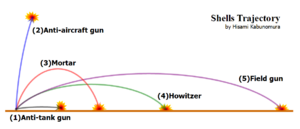Trajectory facts for kids
A trajectory is the path an object takes as it moves through space over a period of time. Imagine throwing a ball or launching a rocket; the curved line it follows from start to finish is its trajectory. This path is shaped by different forces, like how hard you throw something or the pull of gravity.
Contents
What is a Trajectory?
A trajectory is simply the route an object travels. It's not just about where something goes, but also how it gets there. Think of a cannon firing a shell. The shell doesn't fly in a straight line forever. Instead, it follows a curved path, which is its trajectory. This path depends on several things:
- How much gunpowder is used to launch it.
- How heavy the shell is.
- The angle at which the cannon is aimed.
How Forces Affect Trajectories
Many things can change an object's trajectory. The main force affecting most trajectories on Earth is gravity. Gravity pulls objects downwards, making them follow a curved path instead of a straight one.
Other forces that can affect a trajectory include:
- Air resistance: This is the drag or friction caused by air pushing against a moving object. It slows things down and can change their path.
- Initial velocity: This is how fast and in what direction an object starts moving. A faster start usually means a longer trajectory.
- Launch angle: The angle at which an object is thrown or launched greatly affects how far it goes and how high it flies.
Examples of Trajectories in Daily Life
You see trajectories all the time!
- When you kick a soccer ball, its path through the air is a trajectory.
- The arc of water from a garden hose is a trajectory.
- A basketball shot follows a trajectory towards the hoop.
- Even a satellite orbiting Earth follows a specific trajectory, though it's much larger and more complex.
Trajectories in Space
In space, trajectories are super important for sending rockets and spacecraft to other planets or putting satellites into orbit. Without air resistance, objects in space follow paths mostly influenced by the gravity of planets, moons, and stars. Scientists and engineers calculate these trajectories very carefully to make sure spacecraft reach their destinations accurately.
See also
 In Spanish: Trayectoria para niños
In Spanish: Trayectoria para niños


